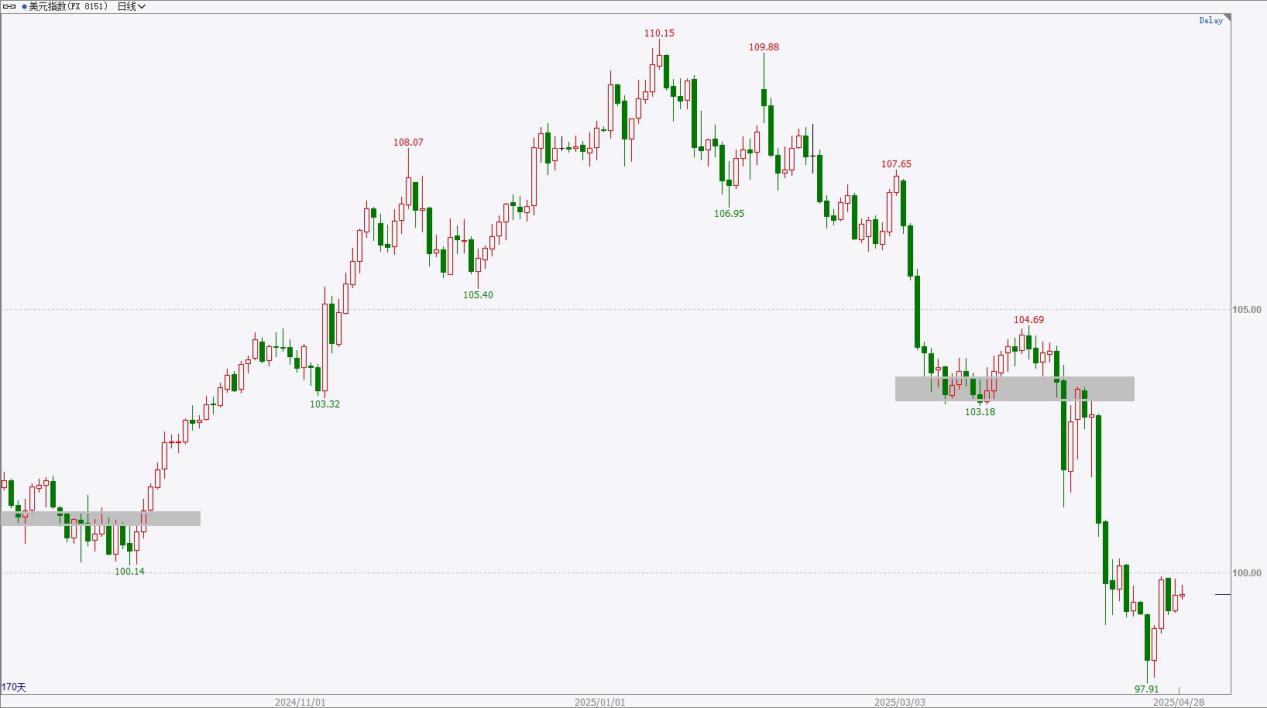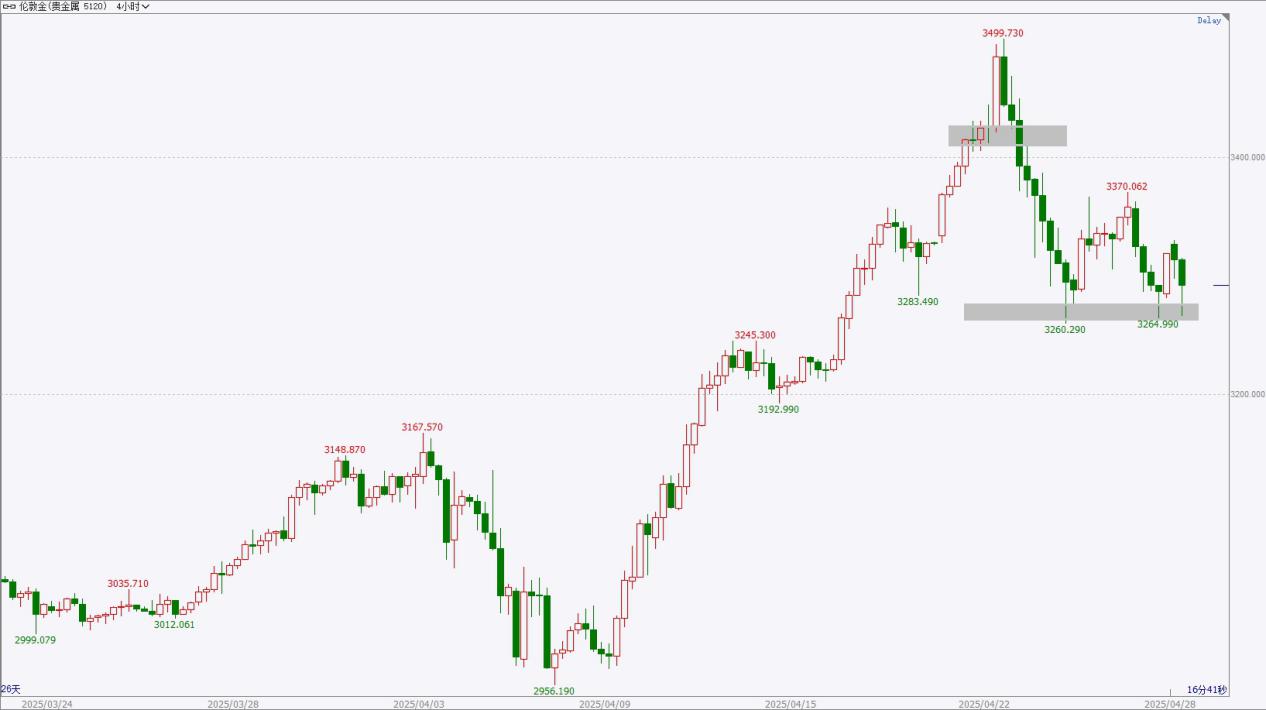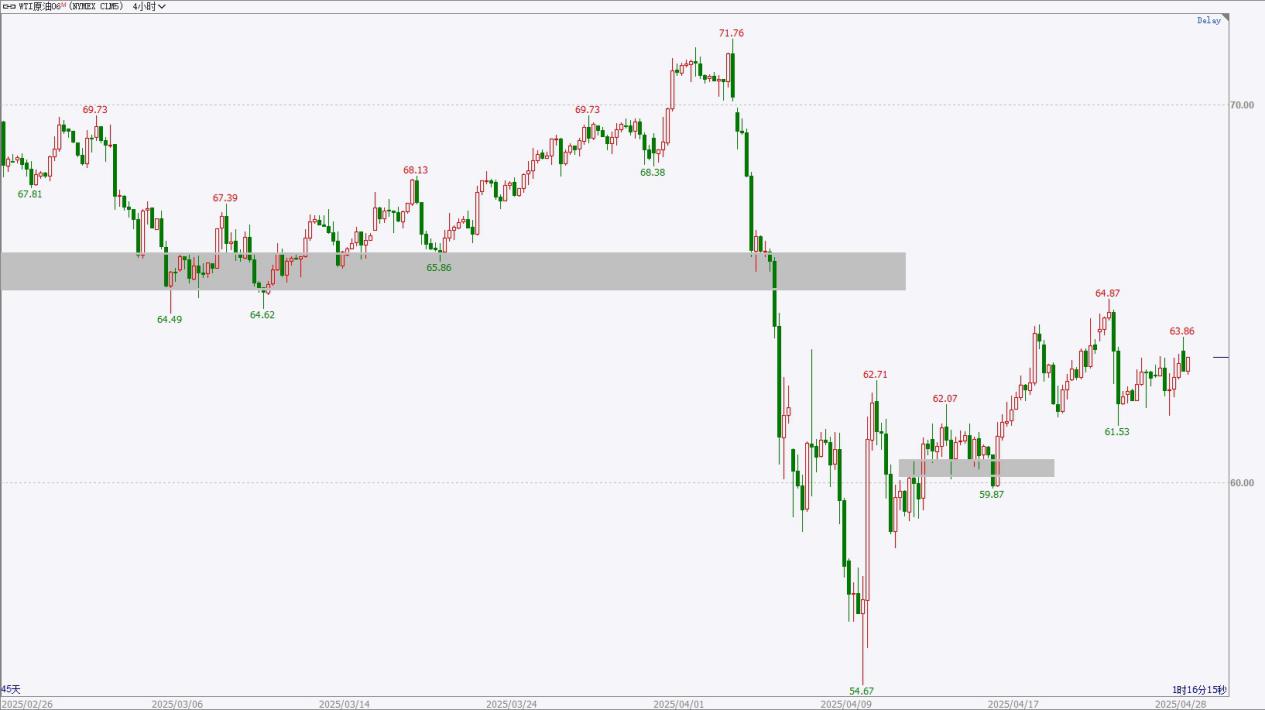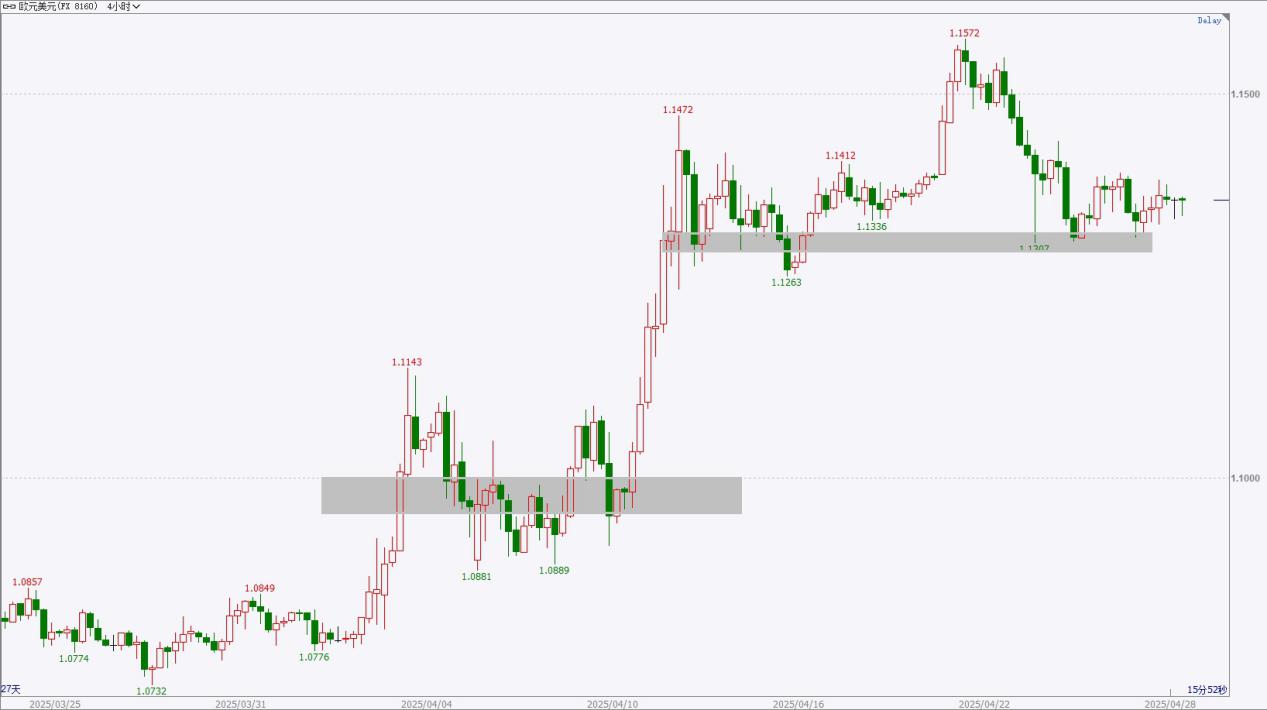|
Time
|
Data and Events
|
Importance
|
|
To be determined
|
Canada holds federal elections
|
★★★
|
|
18:00
|
UK April CBI retail sales balance
|
★★★
|
|
22:30
|
US April Dallas Fed Business Activity Index
|
★★★
|
| |
|
|
| |
|
|
|
Variety
|
Viewpoint
|
Support Range
|
Resistance Range
|
|
US Dollar Index
|
Weak oscillation
|
96-97
|
100-101
|
|
Gold
|
Short-term pullback
|
3260-3270
|
3380-3400
|
|
Crude Oil
|
Short-term rebound
|
60-61
|
65-66
|
|
Euro
|
Strong oscillation
|
1.1300-1.1350
|
1.1600-1.1650
|
*Pre-market views are time-sensitive and limited, are predictions only, for reference and learning purposes, do not constitute investment advice, and the risk of operations is borne by the individual. Investment carries risks; trading requires caution.
Fundamental Analysis:
In the March Federal Reserve meeting, interest rates were kept unchanged, the labor market remained solid, inflation expectations for this year and next were raised, and GDP growth expectations for the next three years were lowered. Starting in April, the pace of balance sheet reduction will slow, and there is uncertainty regarding tariff policies. In March, non-farm payroll data showed an increase of 228,000 jobs, far exceeding expectations, while the unemployment rate slightly rose, indicating a strong labor market. Tariff policies increase market risks and uncertainties. The year-on-year CPI for March showed a slight decline, and expectations for interest rate cuts in the future have risen.
Technical Analysis:

The US Dollar Index rebounded slightly last week, with moderate strength. The current price is close to the resistance area and has not clearly broken above, which may indicate selling pressure. In the short term, it may continue to oscillate; if this structure is broken, the market may strengthen further. Overall, the price has retreated from a high position, breaking below important support areas, and there are no signs of stabilization yet. The upper resistance area is around 100-101, while the lower support area is around 96-97.
Viewpoint: Weak oscillation, short cycle rebound, pay attention to whether the pressure structure can be broken.
*Pre-market views are time-sensitive and limited, are predictions only, for reference and learning purposes, do not constitute investment advice, and the risk of operations is borne by the individual. Investment carries risks; trading requires caution.
Fundamental Analysis:
Geopolitical conflicts in the Middle East continue to escalate, and there is uncertainty in the Eastern European situation. The European Central Bank’s April interest rate decision marked the sixth consecutive rate cut of 25 basis points, with inflation declining smoothly and economic resilience somewhat enhanced. In the March Federal Reserve interest rate decision, rates were kept unchanged, the labor market remained solid, GDP growth expectations were lowered, and the pace of balance sheet reduction will slow. The US March non-farm payroll data showed a significant increase in jobs exceeding expectations, while the unemployment rate slightly rose; the year-on-year CPI for March showed a slight decline, raising expectations for Federal Reserve interest rate cuts. US tariff policies may stimulate gold’s safe-haven attributes.
Technical Analysis:

Gold prices have recently experienced a slight pullback, with a short-term oscillation structure. Currently, it is close to the support area, and there are no signs of stabilization yet. If it clearly breaks below this structure, the market may weaken further. In the short term, the pullback strategy should be maintained, focusing on short opportunities, and profits should be taken in a timely manner. From a long-term perspective, the upward structure is maintained, and it is currently a secondary adjustment, with no signs of stabilization yet. The upper resistance level is around 3380-3400, while the lower support level is around 3260-3270.
Viewpoint: Short-term pullback; consider trying short opportunities and take profits in a timely manner.
*Pre-market views are time-sensitive and limited, are predictions only, for reference and learning purposes, do not constitute investment advice, and the risk of operations is borne by the individual. Investment carries risks; trading requires caution.
Fundamental Analysis:
The April EIA monthly report basically maintains the crude oil production for this year and next, with a slight downward adjustment to global crude oil demand for this year and next; the OPEC monthly report slightly lowers the expected global economic growth rate for this year and next, and adjusts the expected growth in global crude oil demand for this year and next; the IEA monthly report lowers the expected growth in global oil demand for 2025. At the beginning of April, the OPEC+ ministerial meeting maintained the oil production policy unchanged and agreed to exceed expectations for increased production in May. The uncertainty of U.S. tariff policies may affect the demand side. EIA crude oil inventories slightly increased, with a neutral short-term impact.
Technical Analysis:

U.S. crude oil is currently in a volatile structure, with pressure above and support below. Short-term trading is intense, and it may continue to test resistance levels. In the short term, one can try to take long positions at low prices and reduce holdings to take profits at high prices. Overall, crude oil has shown weak performance previously, with a rebound at low levels, but there are no signs of a significant stabilization yet. The upper pressure area is around 65-66, while the lower support area is around 60-61.
Viewpoint: Short-term rebound, attempt to take long positions at low prices, and take profits in a timely manner.
*Pre-market views are time-sensitive and limited, are predictions only, for reference and learning purposes, do not constitute investment advice, and the risk of operations is borne by the individual. Investment carries risks; trading requires caution.
Fundamental Analysis:
The European Central Bank’s April interest rate decision saw a continuous sixth rate cut of 25 basis points, with inflation declining smoothly and economic resilience somewhat enhanced. The bank relies on data, evaluates successively, and dynamically adjusts its monetary policy stance, paying attention to trade situations. The Federal Reserve’s March interest rate decision maintained the status quo, raised inflation expectations, and lowered GDP growth expectations, indicating a slowdown in the pace of balance sheet reduction. In March, U.S. non-farm payroll data showed employment numbers significantly exceeded expectations, while the unemployment rate slightly increased; the March CPI year-on-year rate slightly decreased. The manufacturing PMI values of major Eurozone countries in April were slightly above expectations, with little change from previous values.
Technical Analysis:

The euro price surged and then retreated last week, with a long upper shadow on the weekly chart, but this did not change the larger cycle structure. It is currently in a support area, and attention should be paid to signs of consolidation and stabilization. If this occurs, the market may continue to rise; if it breaks below this structure, the market may weaken. Overall, the larger cycle’s upward structure remains intact, with a short-term adjustment in progress, and attention should be paid to the effectiveness of the support area. The upper pressure area is around 1.1600-1.1650, while the lower support area is around 1.1300-1.1350.
Viewpoint: Volatile but strong, short-term pullback has not yet stabilized, pay attention to the effectiveness of the support area.
*Pre-market views are time-sensitive and limited, are predictions only, for reference and learning purposes, do not constitute investment advice, and the risk of operations is borne by the individual. Investment carries risks; trading requires caution.


Daily Reviews
Our award-winning team of analysts provides keen and insightful technical and fundamental analysis to understand daily market news and investment trading opportunities
HTFX Daily Forex Commentary 0428
Time
Data and Events
Importance
To be determined
Canada holds federal elections
★★★
18:00
UK April CBI retail sales balance
★★★
22:30
US April Dallas Fed Business Activity Index
★★★
Variety
Viewpoint
Support Range
Resistance Range
US Dollar Index
Weak oscillation
96-97
100-101
Gold
Short-term pullback
3260-3270
3380-3400
Crude Oil
Short-term rebound
60-61
65-66
Euro
Strong oscillation
1.1300-1.1350
1.1600-1.1650
*Pre-market views are time-sensitive and limited, are predictions only, for reference and learning purposes, do not constitute investment advice, and the risk of operations is borne by the individual. Investment carries risks; trading requires caution.
Fundamental Analysis:
In the March Federal Reserve meeting, interest rates were kept unchanged, the labor market remained solid, inflation expectations for this year and next were raised, and GDP growth expectations for the next three years were lowered. Starting in April, the pace of balance sheet reduction will slow, and there is uncertainty regarding tariff policies. In March, non-farm payroll data showed an increase of 228,000 jobs, far exceeding expectations, while the unemployment rate slightly rose, indicating a strong labor market. Tariff policies increase market risks and uncertainties. The year-on-year CPI for March showed a slight decline, and expectations for interest rate cuts in the future have risen.
Technical Analysis:
The US Dollar Index rebounded slightly last week, with moderate strength. The current price is close to the resistance area and has not clearly broken above, which may indicate selling pressure. In the short term, it may continue to oscillate; if this structure is broken, the market may strengthen further. Overall, the price has retreated from a high position, breaking below important support areas, and there are no signs of stabilization yet. The upper resistance area is around 100-101, while the lower support area is around 96-97.
Viewpoint: Weak oscillation, short cycle rebound, pay attention to whether the pressure structure can be broken.
*Pre-market views are time-sensitive and limited, are predictions only, for reference and learning purposes, do not constitute investment advice, and the risk of operations is borne by the individual. Investment carries risks; trading requires caution.
Fundamental Analysis:
Geopolitical conflicts in the Middle East continue to escalate, and there is uncertainty in the Eastern European situation. The European Central Bank’s April interest rate decision marked the sixth consecutive rate cut of 25 basis points, with inflation declining smoothly and economic resilience somewhat enhanced. In the March Federal Reserve interest rate decision, rates were kept unchanged, the labor market remained solid, GDP growth expectations were lowered, and the pace of balance sheet reduction will slow. The US March non-farm payroll data showed a significant increase in jobs exceeding expectations, while the unemployment rate slightly rose; the year-on-year CPI for March showed a slight decline, raising expectations for Federal Reserve interest rate cuts. US tariff policies may stimulate gold’s safe-haven attributes.
Technical Analysis:
Gold prices have recently experienced a slight pullback, with a short-term oscillation structure. Currently, it is close to the support area, and there are no signs of stabilization yet. If it clearly breaks below this structure, the market may weaken further. In the short term, the pullback strategy should be maintained, focusing on short opportunities, and profits should be taken in a timely manner. From a long-term perspective, the upward structure is maintained, and it is currently a secondary adjustment, with no signs of stabilization yet. The upper resistance level is around 3380-3400, while the lower support level is around 3260-3270.
Viewpoint: Short-term pullback; consider trying short opportunities and take profits in a timely manner.
*Pre-market views are time-sensitive and limited, are predictions only, for reference and learning purposes, do not constitute investment advice, and the risk of operations is borne by the individual. Investment carries risks; trading requires caution.
Fundamental Analysis:
The April EIA monthly report basically maintains the crude oil production for this year and next, with a slight downward adjustment to global crude oil demand for this year and next; the OPEC monthly report slightly lowers the expected global economic growth rate for this year and next, and adjusts the expected growth in global crude oil demand for this year and next; the IEA monthly report lowers the expected growth in global oil demand for 2025. At the beginning of April, the OPEC+ ministerial meeting maintained the oil production policy unchanged and agreed to exceed expectations for increased production in May. The uncertainty of U.S. tariff policies may affect the demand side. EIA crude oil inventories slightly increased, with a neutral short-term impact.
Technical Analysis:
U.S. crude oil is currently in a volatile structure, with pressure above and support below. Short-term trading is intense, and it may continue to test resistance levels. In the short term, one can try to take long positions at low prices and reduce holdings to take profits at high prices. Overall, crude oil has shown weak performance previously, with a rebound at low levels, but there are no signs of a significant stabilization yet. The upper pressure area is around 65-66, while the lower support area is around 60-61.
Viewpoint: Short-term rebound, attempt to take long positions at low prices, and take profits in a timely manner.
*Pre-market views are time-sensitive and limited, are predictions only, for reference and learning purposes, do not constitute investment advice, and the risk of operations is borne by the individual. Investment carries risks; trading requires caution.
Fundamental Analysis:
The European Central Bank’s April interest rate decision saw a continuous sixth rate cut of 25 basis points, with inflation declining smoothly and economic resilience somewhat enhanced. The bank relies on data, evaluates successively, and dynamically adjusts its monetary policy stance, paying attention to trade situations. The Federal Reserve’s March interest rate decision maintained the status quo, raised inflation expectations, and lowered GDP growth expectations, indicating a slowdown in the pace of balance sheet reduction. In March, U.S. non-farm payroll data showed employment numbers significantly exceeded expectations, while the unemployment rate slightly increased; the March CPI year-on-year rate slightly decreased. The manufacturing PMI values of major Eurozone countries in April were slightly above expectations, with little change from previous values.
Technical Analysis:
The euro price surged and then retreated last week, with a long upper shadow on the weekly chart, but this did not change the larger cycle structure. It is currently in a support area, and attention should be paid to signs of consolidation and stabilization. If this occurs, the market may continue to rise; if it breaks below this structure, the market may weaken. Overall, the larger cycle’s upward structure remains intact, with a short-term adjustment in progress, and attention should be paid to the effectiveness of the support area. The upper pressure area is around 1.1600-1.1650, while the lower support area is around 1.1300-1.1350.
Viewpoint: Volatile but strong, short-term pullback has not yet stabilized, pay attention to the effectiveness of the support area.
*Pre-market views are time-sensitive and limited, are predictions only, for reference and learning purposes, do not constitute investment advice, and the risk of operations is borne by the individual. Investment carries risks; trading requires caution.
Latest Reviews
HTFX Daily Forex Commentary 0819
HTFX Daily Forex Commentary 0815
HTFX Daily Forex Commentary 0812
HTFX Daily Forex Commentary 0811
Choose a Trusted Broker for Trading
Over 300 employees worldwide, more than 1,000 products, top-tier liquidity